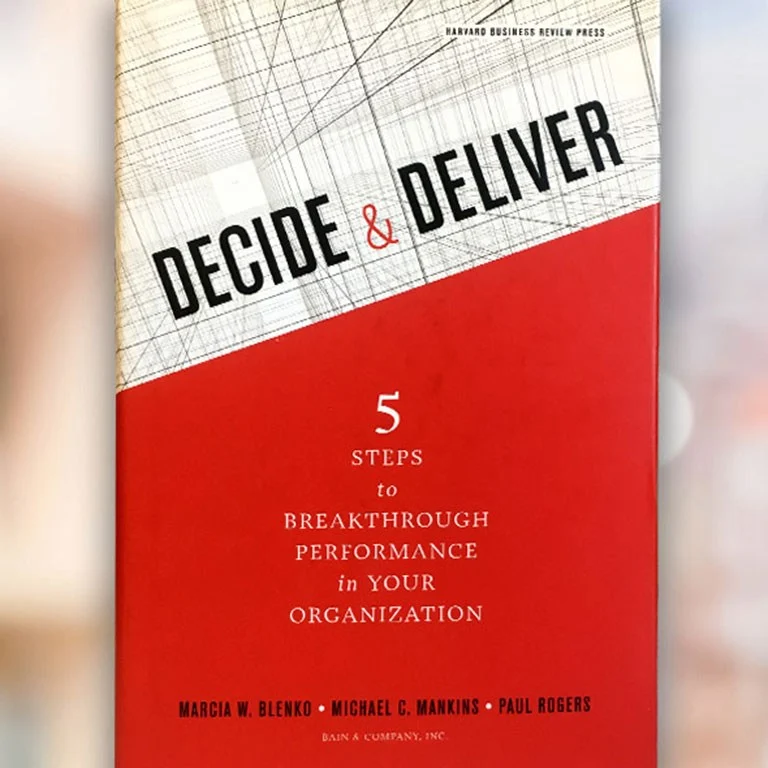Article
In business, every opportunity seized or missed is the result of a decision that someone made or failed to make. No matter how clever your company's strategy is, if the right decisions aren't made effectively—and executed quickly and consistently—your business will lose ground.
A Bain & Company survey of more than 350 global organizations suggests that only about 15% of companies practice effective decision making. Many score well on the big decisions—which markets to enter or exit—but high performers truly shine when it comes to critical operating decisions requiring consistency and speed-driving product innovation, positioning brands or managing channel partners.
Even in companies respected for decisiveness, ambiguity about who is accountable often stalls the decision-making process at one of four common bottlenecks: global versus local, center versus business unit, function versus function or inside versus outside partners.
We use an approach we call RAPID®—recommend, agree, perform, input and decide—to help companies develop clear decision-making guidelines. As you'll see, the roles aren't carried out lockstep in that order; we took some liberties in creating a useful acronym. Nor is the process a panacea—an indecisive decision maker can ruin any good system—but it's an important start in clearing bottlenecks.
To see how it works, consider what happened at Wyeth Pharmaceuticals when it looked to establish a leading position with a promising new drug called Enbrel. Competitors were also working on the same class of drug, and Wyeth needed to move quickly to expand production capacity by building a plant in Ireland.
By any standard, the issues were complex. Input typically filtered up through a gauze of overlapping committees, progressing slower than the competitive situation demanded. Eager to find a better way, company executives turned to RAPID. They started by identifying those people best suited to recommend a course of action—either by making a proposal or offering alternatives—and pushed certain responsibilities down to the business units, where knowledge was greatest.
Others then were asked to agree to a recommendation before it moved forward. In this case, Wyeth's top executives retained veto power (they had to agree) over many important proposals.
With RAPID, however, if someone exercises a veto, he or she must offer an alternative or escalate the issue to the person with the "D." And only a few should have such veto power: legal counsel, for certain decisions, or the head of an affected unit. Those with input responsibilities provide relevant information-effective decisions, after all, are grounded in evaluating facts rather than seeking opinions. The recommender has no obligation to act on the advice but should take it into account, since the people who will implement a decision are typically among those providing input. Consensus is a worthy goal but can be an obstacle to action or a recipe for lowest-common-denominator compromise.
In the end, it comes down to one person who must decide—the single point of accountability who commits the organization to action. He or she needs good business judgment, a grasp of the trade-offs and an awareness of the group that will execute the decision.
Many decisions about Enbrel, for instance, lay with Cavan Redmond, executive vice president and general manager of Wyeth's biotech division, after he and his team gathered input from other managers. But in the end, responsibility for executing Wyeth's plan rested firmly with the business unit. The people who perform have a crucial role: A good decision executed well often beats a brilliant one implemented poorly.
No single lever turns a company that struggles to make and execute good decisions into a decision-driven organization, of course, but you'll know your company is on track when managers find they're spending less time in meetings wondering why they are there. And when one person has the "D," bottlenecks will disappear.
By taking some practical steps, any company can become more effective, beginning with its next decision.
Paul Rogers is a partner with Bain & Company in London and leads Bain's Global Organization practice. Marcia Blenko is a Bain partner in Boston and the leader of Bain's North American Organization practice.
For a fuller account of how your organization can become more decisive, read "Who Has the D? How Clear Decision Roles Enhance Organizational Performance," by Paul Rogers and Marcia Blenko, from the 2006 January issue of Harvard Business Review.
Learn about Bain's Organization consulting expertise
RAPID® is a registered trademark of Bain & Company, Inc.

Decide & Deliver
Learn more about the five steps that leading organizations use to make great decisions quickly and execute them effectively.